
Home made pizza using fresh yeast dough recipe
Dough preparation and rising: 3 ½ hoursMaking one pizza base and topping it: 5 minsCooking: 7-10 minsDifficulty: MediumThere are as many pizza styles as the number of Italians doing it, so I am not here saying that my style is the perfect one, but if you are going to make an homemade pizza for your family or friends, this is what you need to surprise them! Just remember that a good pizza should be very thin, crispy and easy to digest.Dough preparation is an important stage of pizza making, as well as choosing the right flour. Topping the pizza is up to you and at the end of this section I will present you three traditional topping options, which are my favourites.In the list of dough ingredients you will see that I am using the baker’s percentage beside the ingredients, all measured by weight. It means that the flour is always considered 100% and the other ingredients are a percentage of the flour weight. This way you can scale a recipe up and down to suit the number of guests; you can use 1Kg, 10kg, 100kg of flour and the other ingredients are added as a percent of the flour amount you are going to use.
Equip your kitchen – Available at Amazon now
Clicking on equipment pictures takes you to Amazon where you can buy the items. We get a small revenue share of anything you buy which helps keep the site running.
Ingredients
- 500 grams (1.1 lb) Italian "00" or "0" type flour for pizza (alternatively use plain flour) bp 100% With 500 g (1.1 lb) of flour you should be able to make 5 large pizza bases of about 30 cm diameter.
- 15 grams Fresh yeast (fresh compressed yeast) bp 3%
- 10 grams (1 tablespoon) Fine sea salt bp 2%
- 5 grams (1 teaspoon) Malt extract bp 1% – optional
- 20 grams (2 level tablespoons) Extra virgin olive oil bp 4%
- 300 grams (½ pint + 1 fl oz) Tepid water bp 60% The easiest way to make tepid water is to mix two parts cold water with one part boiling water. However, when preparing the tepid water, be aware that above 46ºC (115ºF) the yeast will start suffering because of the excessive heat and ultimately it will die if the water temperature reaches 63ºC (145ºF).The exact equivalent, in volume, of 300 g of water is 300 ml. This does not apply with other liquids or liquid fats (i.e. olive oil).
Instructions
- Put the flour into a large bowl and sprinkle with salt. Using your hands or a wooden spoon, stir to evenly distribute the salt within the flour.
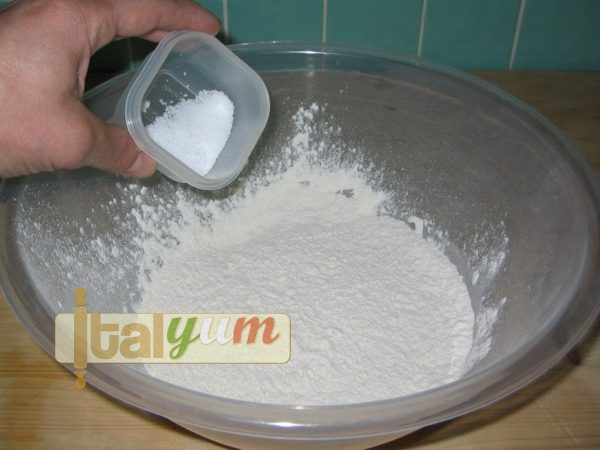
- Crumble the fresh yeast with your hand and add it into the bowl.
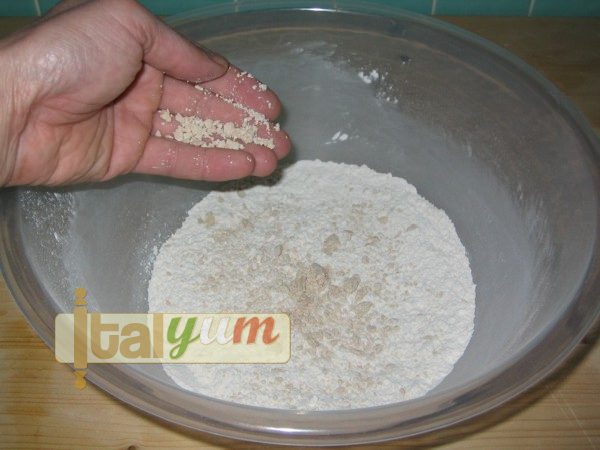
- Rub the fresh yeast through the flour, to further break it down (1 or 2 minutes will be sufficient).
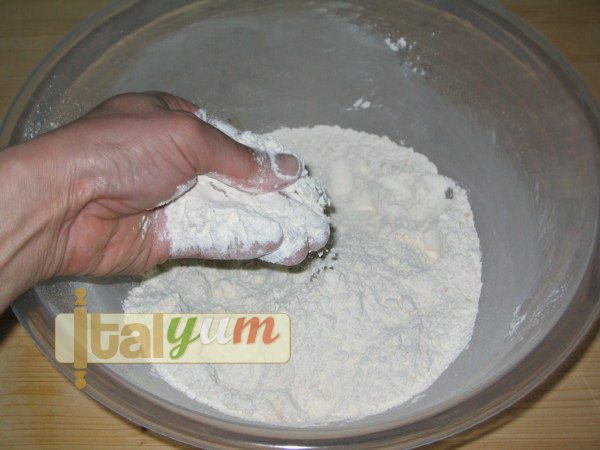
- Add the malt extract to the water and stir. It should dissolve in few seconds.
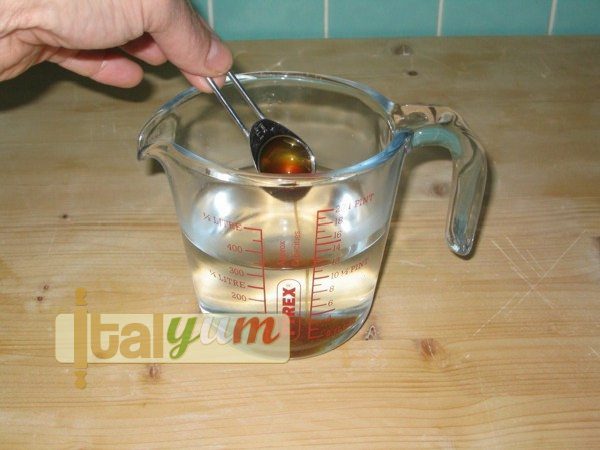
- Add the water and malt mix into the bowl.
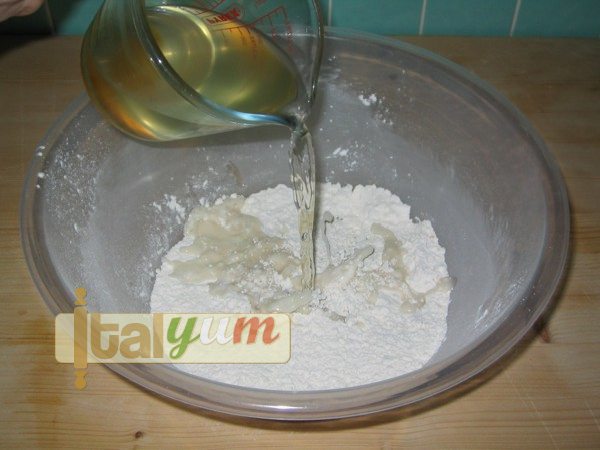
- Add the olive oil into the bowl.
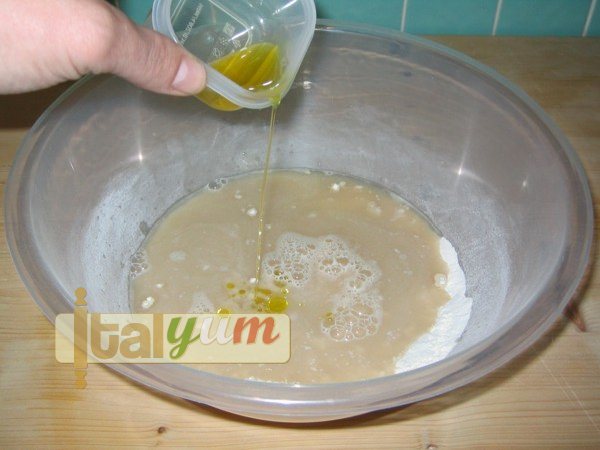
- Using your hand, start mixing in circular motion.
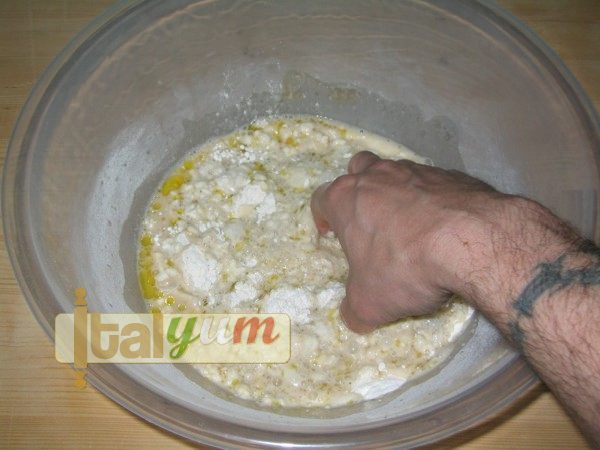
- Keep mixing until all the ingredients come together.
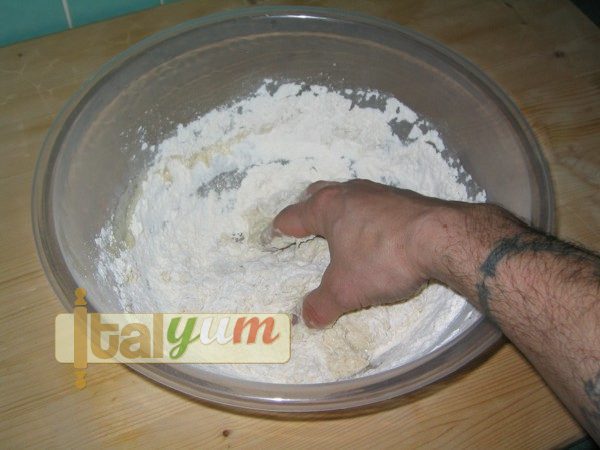
- After a couple of minutes mixing, you should have a dough at its early stage of development. Now, we knead the dough so that it can develop the gluten and become firmer.
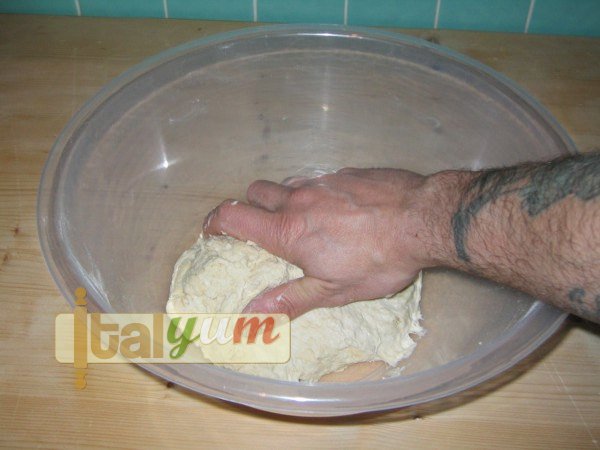
- The pizza dough in this recipe has 60% hydration. This quantity of water should give you a firm dough, however not all the pizza flours have the same quantity of proteins, so if you end up using a pizza flour at its lowest protein content, during a very humid day, you may have to knead a soft dough instead of a firm dough. If that is the case, knead the dough using the stretch and fold method (watch this short video).
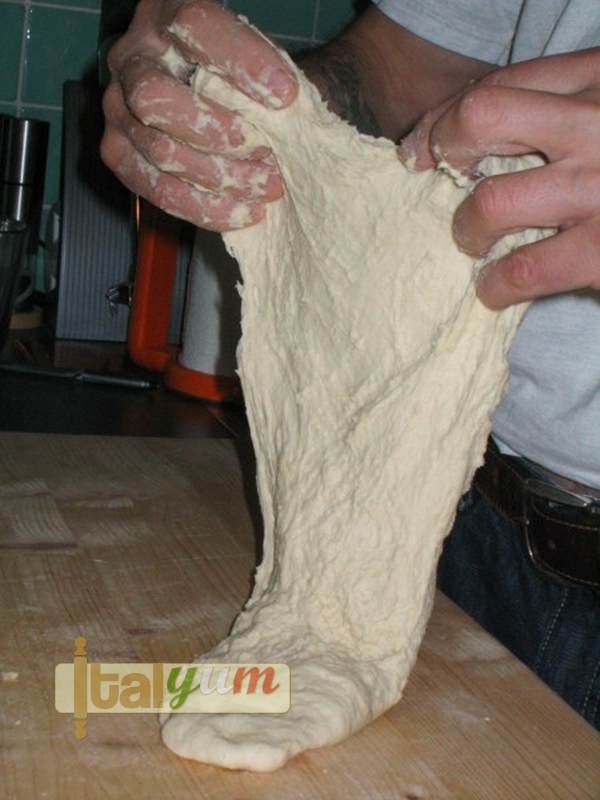
- Kneading wet dough
- If your dough is firm, then knead the dough using the push, roll and turn method (watch this short video).
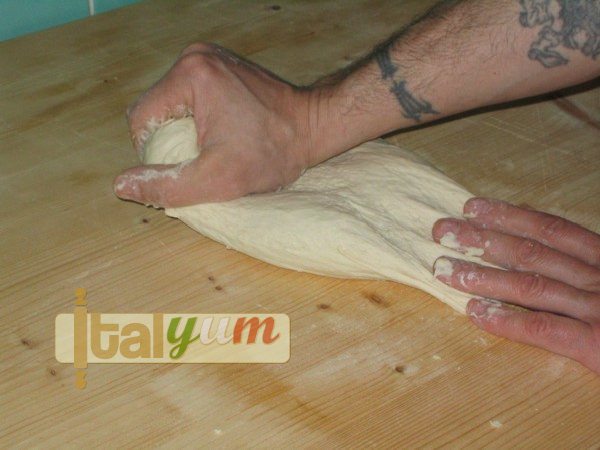
- Kneading Pizza Dough – normal firm consistency dough
- In my case, the dough was firm, so I opted for the second method. It is important that you do not add any extra flour. Keep kneading for at least 10 minutes and slowly you will see the dough coming together and becoming firmer and firmer.
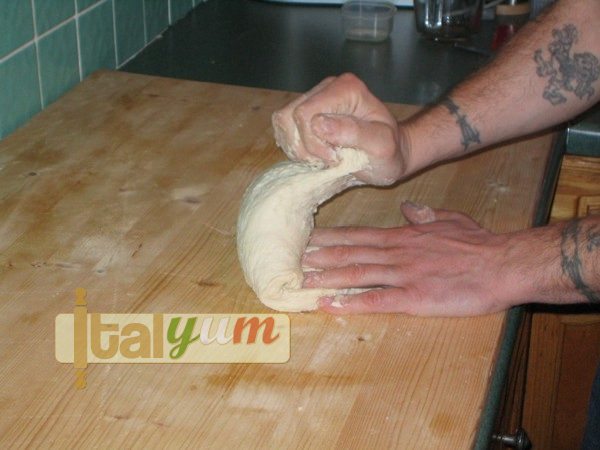
- When the dough has been kneaded for at least 10 minutes, you should have a smooth, silky and elastic dough. Now, we need to shape the dough into a ball. To do so, lift and fold the outer edges of the dough towards the centre, while rotating the dough at the same time and tucking the edges into the centre of the ball (watch this short video).
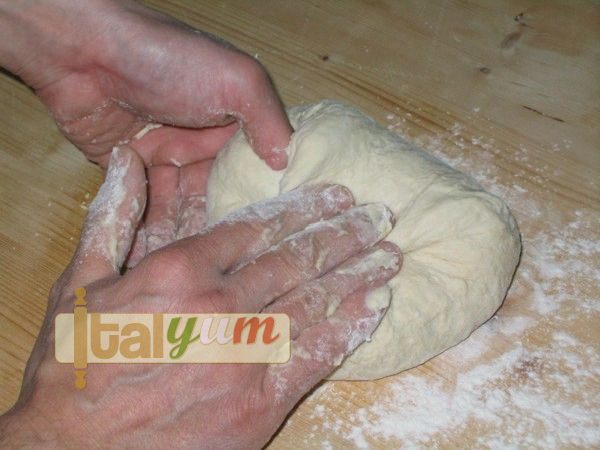
- Anything between six and eight folds should be enough.
- When finished, turn the dough over and with both hands rotate the dough while applying gentle pressure to the bottom (as if tucking the dough underneath).
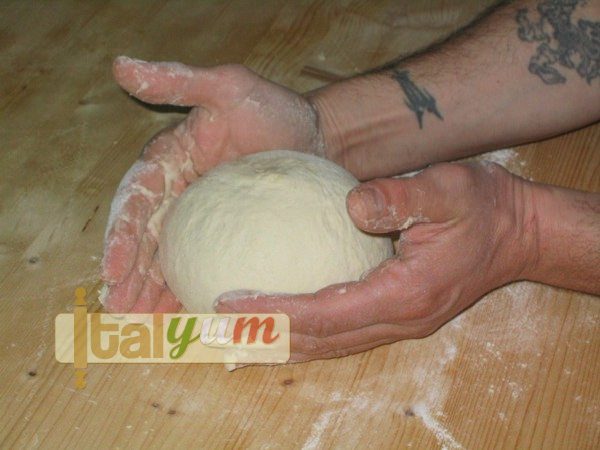
- If the above instruction has been carried out correctly, you should end up with a ball like this one.
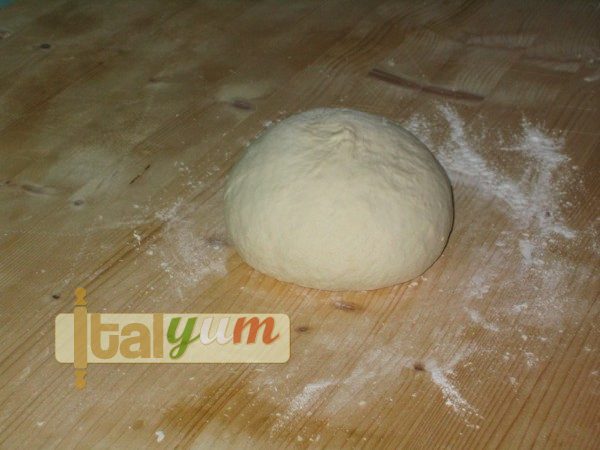
- Grease the inside of a large bowl with a thin coat of olive oil.
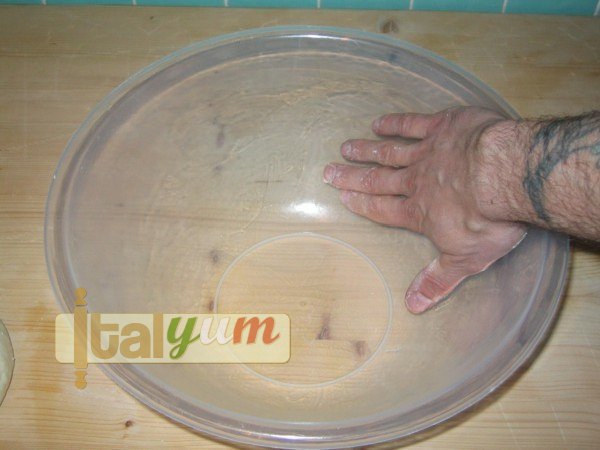
- Roll the ball inside the bowl, lightly coating the surface of the ball with oil.
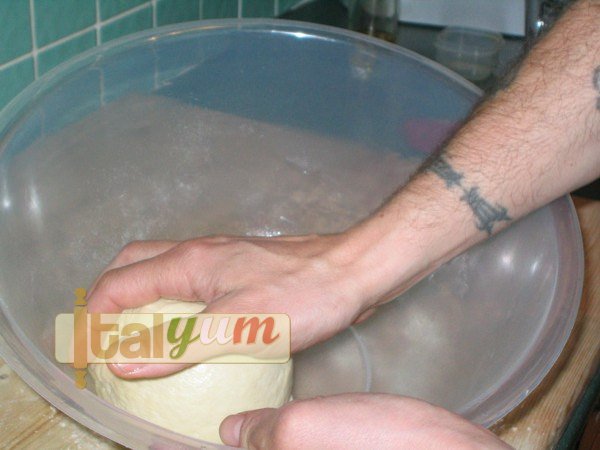
- Cover the bowl and leave the dough to rise for a couple of hours. This is called bulk fermentation.
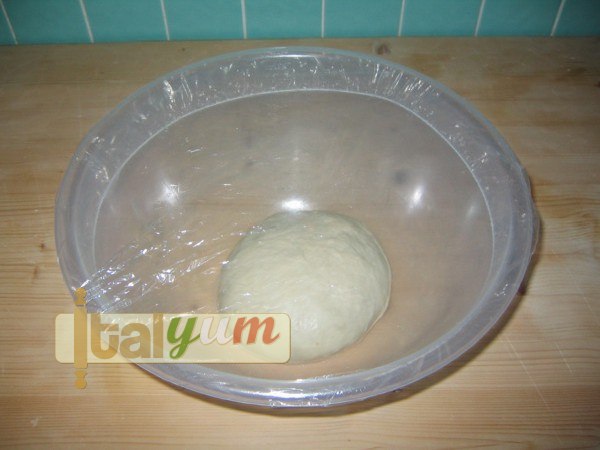
- Before we do anything with our dough, we need to wait until it has raised properly. I have seen recipes around, saying “raise until it has double in volume”; this sometimes can happen in less than one hour; this time is not enough to develop the dough structure and flavour, so I advise to stick to 2 hours.
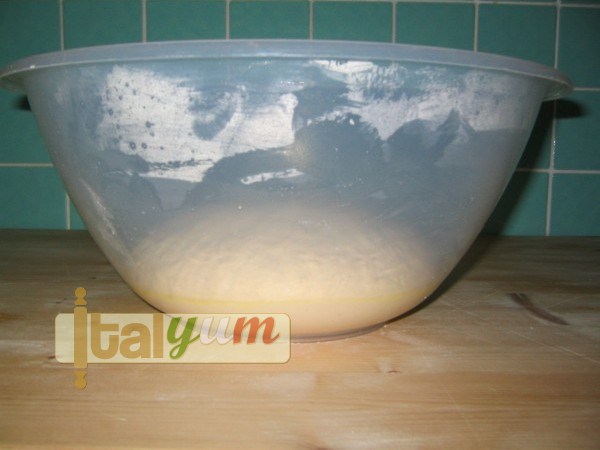
- This is the pizza dough after two hours bulk fermentation.
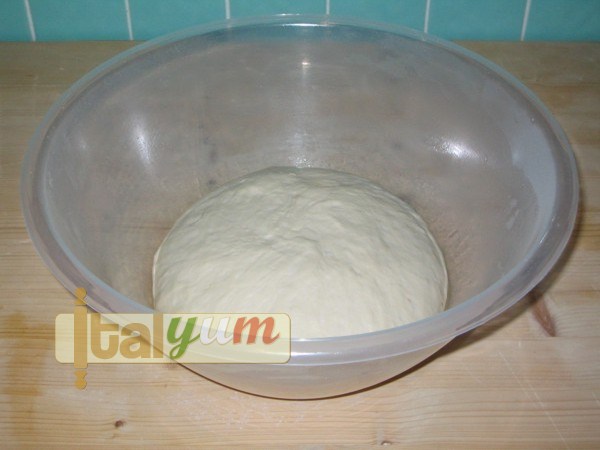
- Next, divide the dough in five segments of equal weight (150-160 g each).
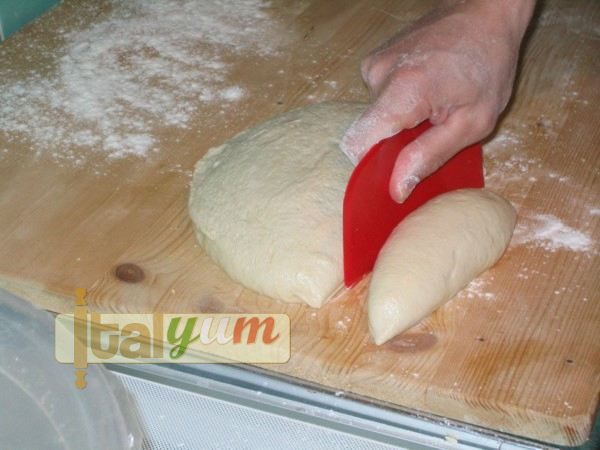
- Make a ball out of each segment. To do so, roughly pre-shape the segment into a ball, then cup your hands over the ball. Press down and move your hand in a circular motion, while keeping the hand cupped. This action will compact the ball into a tight round shape (watch this short video).
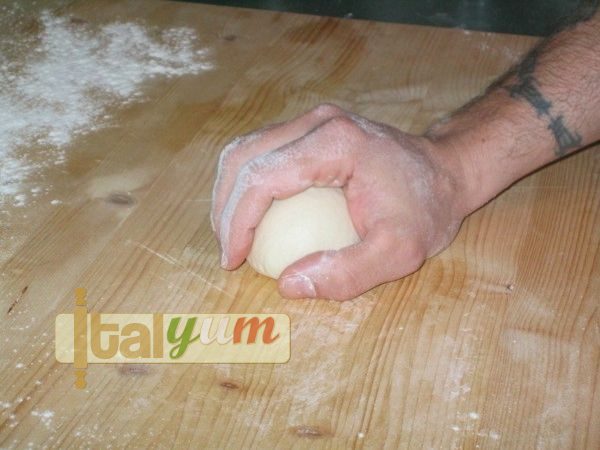
- Cutting your Pizza dough into smaller balls.
- Spread some flour over the working surface and lay your dough balls onto it.
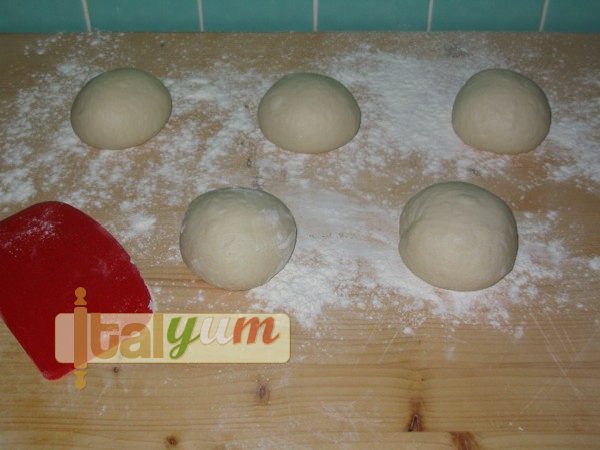
- Cover the dough balls with a dry cloth and leave them to rest for 1 hour. This time is called final fermentation.
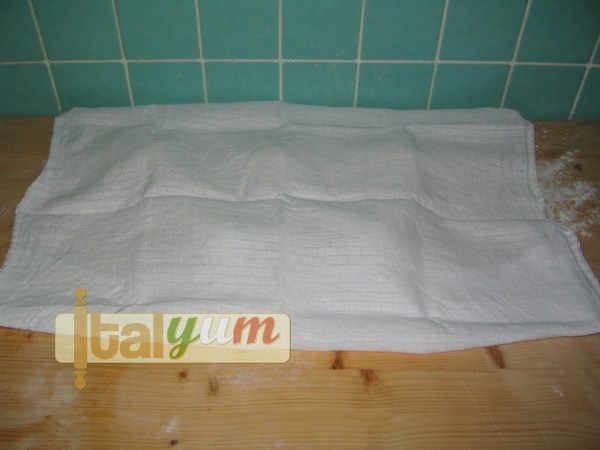
Preparation of the pizza base:
- Once the final fermentation is completed, lightly flour the working surface and take the first dough ball. Using a rolling pin, start rolling so that you can make a large circle.
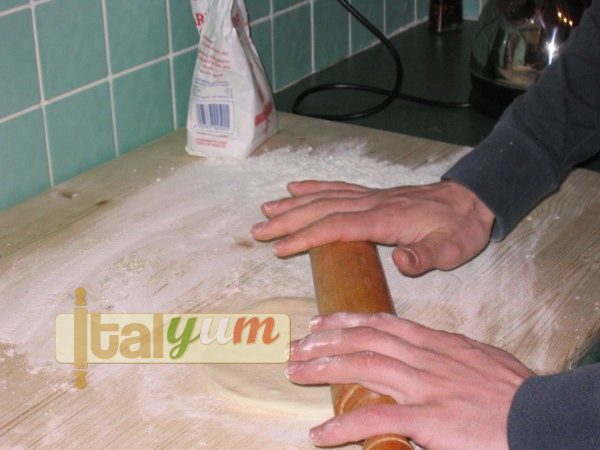
- The pizza base should match a 30 cm (12") diameter pizza tray.
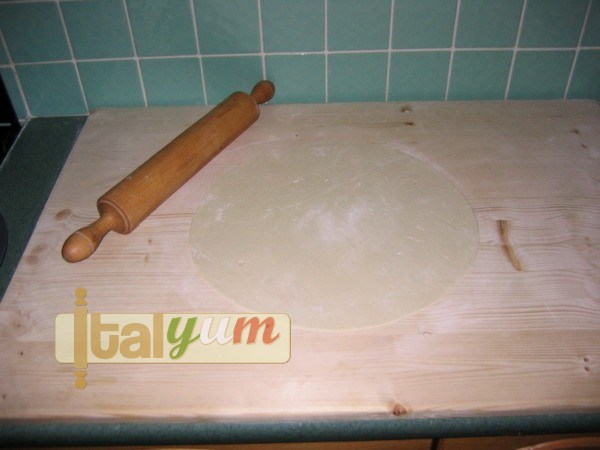
- The pizza base should be very thin; I would say 2 or 3 millimetres (1/16" or 1/8") thick.
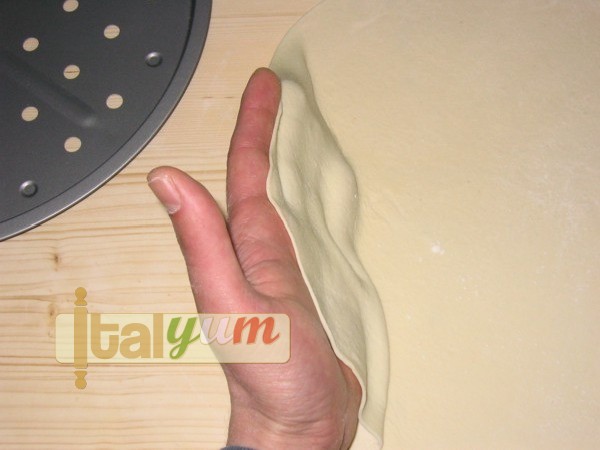
- Be sure that the bottom of the pizza base is appropriately floured before to drag it over the pizza tray. I like to make the base a bit larger than the tray, so that I can make a rim folding the outer edge towards the centre, but you can also decide to make a smaller circle and have a flat outer edge.
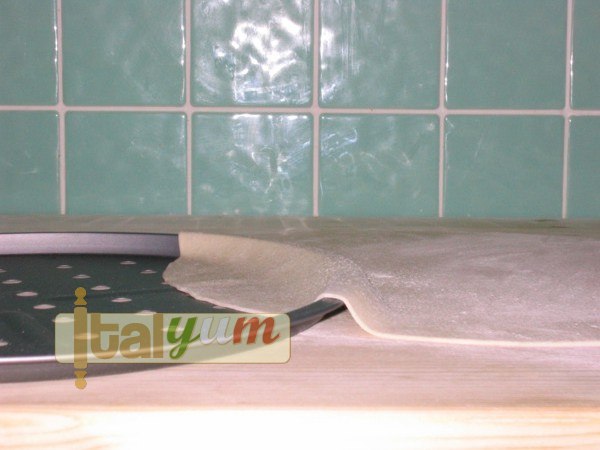
First stage of topping the pizza (the tomato sauce): These first steps are usually the same for all the different styles of pizza.
- To prepare the tomato sauce, add a dash of olive oil into a saucepan and pour a can of peeled plum tomatoes into the pan.
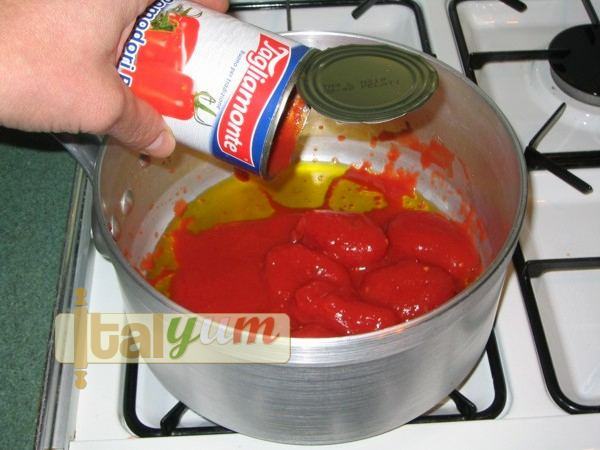
- Break down the tomato to avoid having big chunks (the most effective way is to use a potato masher). Add a pinch of salt and simmer for about 15 minutes. This will eliminate some of the water in the tomato sauce and increase its flavour.
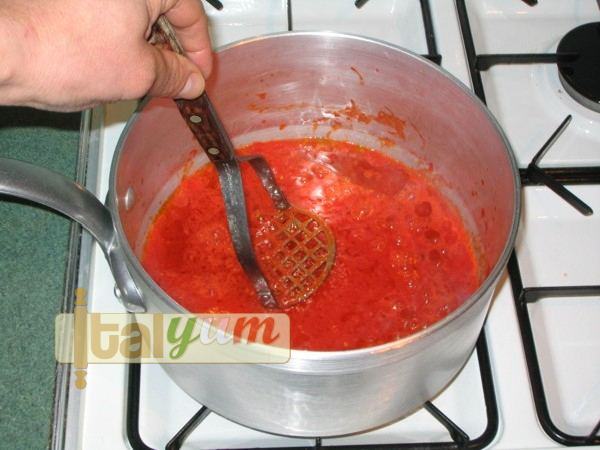
- When the sauce has reduced to the right consistency, pour it into a small bowl and use it to top the pizza base as directed below. At this stage, do not add any oregano, because not all pizzas require oregano.
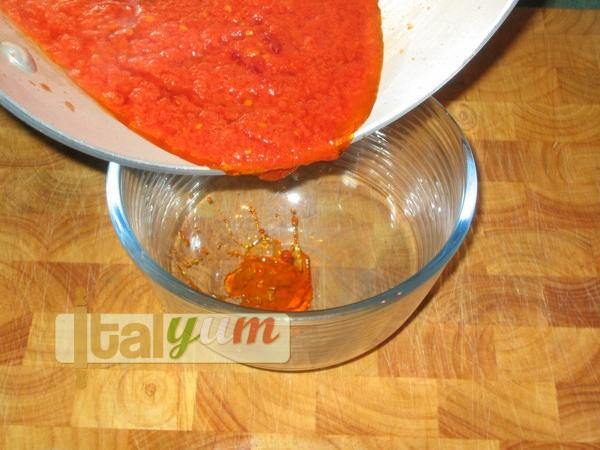
- With a small spoon spread the tomato topping onto the pizza base. I normally put three or four spoons and I spread the tomato moving outwards in circles. Add other spoons if you need to, but do not make a pond; the tomato should just colour the base.

- This is the finished job. Remember to leave a white border of about 1 cm.From now on, we start the differentiation according to the pizza topping we would like to have. I will be vague about the quantity of the ingredients because, as you will see, it is just up to you and your taste.

Pizza 4 stagioni (4 seasons pizza)
- Start grating some mozzarella. You can use mozzarella specifically suitable for pizza (available in any supermarket) or mozzarella balls packed in small plastic bags: these bags contain water so pat dry the mozzarella before grating it.
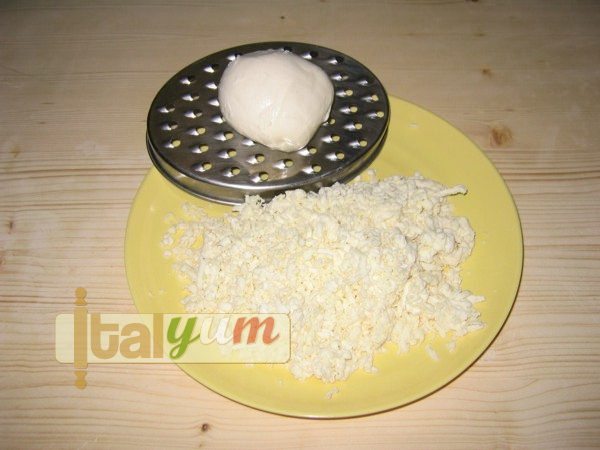
- Now, prepare the rest of the ingredients. Here we have some grated mozzarella (as above), some cooked ham (cut into pieces), some mushrooms (the best are the ones you can buy at the supermarket, preserved in sunflower oil), some small artichokes (preserved in sunflower oil) and finally some pitted black and green olives.

- Spread the pizza base with some mozzarella.

- Spread with some cooked ham.

- Spread with some mushrooms, artichokes and olives.

- Finally, complete with a dash of extra virgin olive oil.Always pre-heat the oven, to ensure baking the pizza straightaway at the right temperature. The oven should be set at the maximum temperature (usually 240ºC – 465ºF). If the oven is at the right temperature and your pizza is thin, it should take about 7/10 minutes to cook. Fan assisted ovens may require a different cooking time. After 5 minutes cooking, checking the pizza frequently is a good idea. When the border starts to become golden brown, it is probably the right time to take the pizza out of the oven.

Pizza prosciutto di Parma e funghi (Pizza with Parma hum and mushrooms)
- Start grating some mozzarella. You can use mozzarella specifically suitable for pizza (available in any supermarket) or mozzarella balls packed in small plastic bags: these bags contain water so pat dry the mozzarella before grating it.

- Now, prepare the rest of the ingredients. Here we have some grated mozzarella (as above), some Parma ham slices and some mushrooms (the best are the ones you can buy at the supermarket, preserved in sunflower oil).

- Spread the pizza base with some mozzarella.

- Place some Parma hum slices onto the pizza base.

- Spread with some mushrooms.

- Finally, complete with a dash of extra virgin olive oil.Always pre-heat the oven, to ensure baking the pizza straightaway at the right temperature. The oven should be set at the maximum temperature (usually 240ºC – 465ºF). If the oven is at the right temperature and your pizza is thin, it should take about 7/10 minutes to cook. Fan assisted ovens may require a different cooking time. After 5 minutes cooking, checking the pizza frequently is a good idea. When the border starts to become golden brown, it is probably the right time to take the pizza out of the oven.

Pizza formaggio e funghi ( Pizza cheese and mushrooms)
- Start grating some mozzarella. You can use mozzarella specifically suitable for pizza (available in any supermarket) or mozzarella balls packed in small plastic bags: these bags contain water so pat dry the mozzarella before grating it.
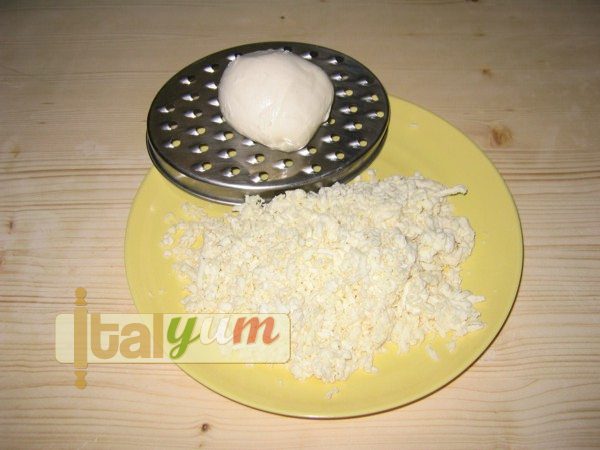
- Now, prepare the rest of the ingredients. Here we have some grated mozzarella (as above), some Parmesan cheese shavings, some Swiss Emmenthal cheese cut into small pieces and finally some mushrooms (the best are the ones you can buy at the supermarket, preserved in sunflower oil).

- Spread the pizza base with some mozzarella.

- Add the Parmesan cheese shavings.

- Add the Emmenthal cheese.

- Spread with some mushrooms.

- Finally, complete with a dash of extra virgin olive oil.Always pre-heat the oven, to ensure baking the pizza straightaway at the right temperature. The oven should be set at the maximum temperature (usually 240ºC – 465ºF). If the oven is at the right temperature and your pizza is thin, it should take about 7/10 minutes to cook. Fan assisted ovens may require a different cooking time. After 5 minutes cooking, checking the pizza frequently is a good idea. When the border starts to become golden brown, it is probably the right time to take the pizza out of the oven.Other pizzasRead the section ”First stage of topping pizza” and prepare the pizza base accordingly.From now on, you can decide among these other options:Spread some fresh mozzarella (grated) and drizzle with olive oil. Before serving the pizza, top it with some fresh basil leaves. This pizza is called “Margherita”.orSpread some oregano, some anchovy fillets, some green and black olives, some capers and sprinkle with olive oil. This pizza is called “Siciliana”.orSpread some mozzarella, some Parmesan cheese shavings, some Gorgonzola cheese (or Stilton), some Emmenthal cheese (or Cheddar) and sprinkle with olive oil. This pizza is called “4 formaggi”.orSpread some oregano, some onion slices (finely sliced), some Pecorino cheese shavings and sprinkle with olive oil. Before serving the pizza, top it with some fresh basil leaves. This pizza is called “Pugliese”.Do not forget that many Italians like to give a final touch, when the pizza is hot on the table, with some drops of “hot chilli oil” (check the “hot chilli oil” recipe, featured in the specials section of the website.

Nutrition
Calories: 650kcal
Tried this recipe?Let us know how it was!





This pizza dough recipe is fabulous! My dough was quite sticky but I followed the instructions to keep kneading and slapping and turning until it became smooth and elastic. It bulked up a lot after leaving it covered in the warm kitchen and I had enough for 6 pizza bases. It was very stretchy and elastic so the base was lovely and thin. Tomato sauce as per your suggestion then some mushrooms, mozzarella and parmesan with a sprinkling of oregano, olive oil and a few basil leaves. Absolutely scrumptious, thank you so much. I have frozen the remaining pizza balls for later.
Hi, just trying this out for the first time. My question is that after the two hour bulk fermentation can i put the dough into the fridge overnight or make the balls and then put them into the fridge? I’m planning to make the pizzas tomorrow. Thank you
Aniko, it is fine to put the dough in the fridge. This is called cold proofing, and it will help the dough to develop more flavor and a more tender texture. Enjoy!
Thank you – just found this reply. I did put it in the fridge and actually after the pizza party it stayed there for 5 days then i baked a loaf of bread from the leftover dough. Great recipe, i’m about to make it again. Cheers
Looks like a great recipe. One question, is it a myth that you should use a rolling pin?
Pizza dough needs to be light and fluffy. Using a rolling pin will compress the dough too much.